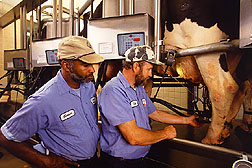Coupled Antibodies Fend Off Mastitis
Inside a dairy cow's mammary gland, immune cells that seek out and destroy invading bacteria have a tough time finding their targets. Staphylococcus aureus and other mastitis pathogens have a capsule that makes recognition by immune cells difficult. As a result, a dairy producer with 100 cows can expect 50 to 80 obvious cases of mastitis in the herd each year.
Despite antibiotics, mastitis costs the U.S. dairy industry more than $2 billion annually, says dairy scientist Max J. Paape, who is with the Agricultural Research Service
Antibiotics are part of this cost, and they can cause other headaches, Paape says. The drugs are often ineffective because of resistant pathogens or, in older cows, repeated treatments. Producers have to wait a few days to sell milk from antibiotic-treated cows. Cows that don't respond are often sold for meat--increasing the chance of antibiotic-contaminated beef.
So Paape and his assistants are collaborating with scientists at the National Institute for Agronomic Research in Nouilly, France, and at the National Cancer Institute (NCI) in Bethesda, Maryland, to develop a treatment they hope will help cows fight infection naturally.
Coupled, or bifunctional, antibodies are proving effective against human cancers in clinical trials of patients who don't respond to traditional therapy, says Paape. He is with the Immunology and Disease Resistance Laboratory in Beltsville, Maryland. "This is the first such antibody developed for domestic animals," he says.
The theory, Paape explains, is that when this coupled antibody is injected into the mammary gland, one end hooks up to a pathogen--say, S. aureus. The other end snags its "terminator"--a specialized white blood cell, called a neutrophil, from the cow's immune system. This contact triggers the neutrophil to release a lethal spray of hydrogen peroxide. With the bacterium literally handcuffed to the neutrophil, the hydrogen peroxide bath can't miss: mastitis meltdown!
Yan Wang, a doctoral candidate working in Paape's lab, made monoclonal antibodies that bind to a few of these trigger proteins on the surface of bovine neutrophils. Paape enlisted French researchers Pascal Rainard and Bernard Poutrel to construct a monoclonal antibody that zeros in on a specific molecule on the capsule of S. aureus. Then Paape worked with NCI's David Segal to chemically stitch together the two monoclonals.
A new research associate in Paape's lab, Grant Tomita, will devote 2 years to studying this and other bifunctional antibodies in vitro-- that is, in culture in a laboratory--and in the cow herself. If they significantly increase the killing power of the cow's immune cells, the system will have to be tweaked for the most effective on-farm application, says Paape. But he already envisions more bifunctionals to treat many other infectious agents in a variety of farm animals.--By Judy McBride, Agricultural Research Service Information Staff.
Max J. Paape and Yan Wang are at the USDA-ARS Immunology and Disease Resistance Laboratory, Bldg. 173, 10300 Baltimore Ave., Beltsville, MD 20705-2350; phone (301) 504-8302, fax (301) 504-9498.
"Coupled Antibodies Fend Off Mastitis" was published in the June 1998 issue of Agricultural Research magazine. Click here to see this issue's table of contents.







